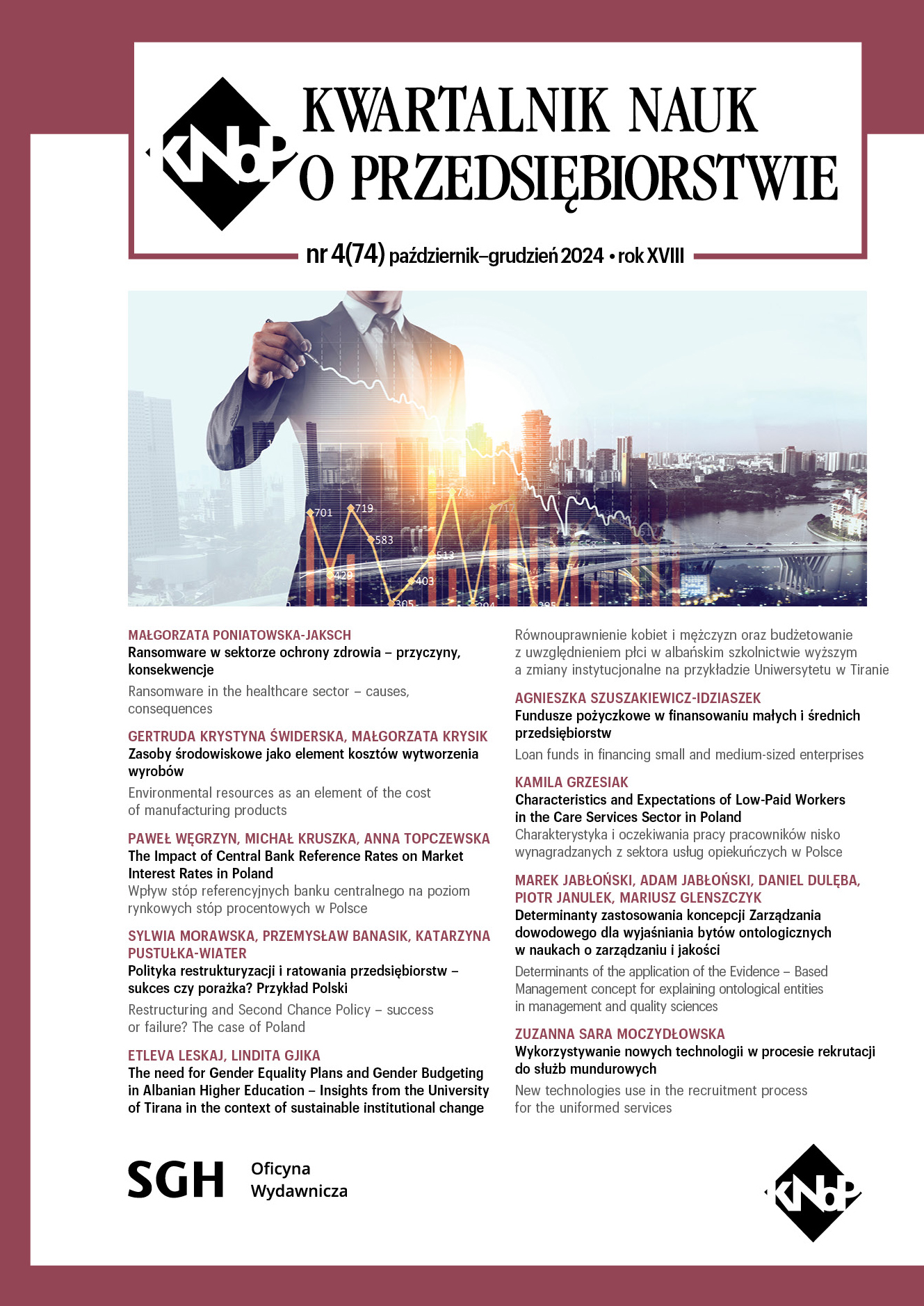Wpływ stóp referencyjnych banku centralnego na poziom rynkowych stóp procentowych w Polsce
Abstrakt
Celem niniejszego opracowania jest określenie wpływu referencyjnej stopy procentowej Narodowego Banku Polskiego (NBP) na poziom wskaźników referencyjnych stopy procentowej WIBOR3M i 6M. Hipoteza badawcza zakłada, że podstawowe stopy procentowe są główną determinantą poziomów wskaźnika referencyjnego WIBOR. W artykule zastosowano testy przyczynowości Grangera oraz model ARDL w celu określenia, która zmienna makroekonomiczna w największym stopniu wpływa na kształtowanie się wskaźnika referencyjnego WIBOR 3M i 6M. Wyniki modelu ARDL jednoznacznie sugerują, że na poziom WIBOR wpływa przede wszystkim referencyjna stopa procentowa NBP, wykazując pozytywny i statystycznie istotny wpływ. Z kolei testy przyczynowości Grangera wskazują, że historyczna referencyjna stopa procentowa nie może być wykorzystana do prognozowania poziomów WIBOR 3M i 6M. Można to uzasadnić tym, że to nie dane historyczne, a oczekiwania dotyczące kształtowania się przyszłych stóp procentowych wpływają na poziom wskaźnika referencyjnego WIBOR.
Full Text
Bibliografia
Ahmed Z., Zhang B., Cary M. [2021], Linking economic globalization, economic growth, financial development, and ecological footprint: Evidence from symmetric and asymmetric ARDL, “Ecological Indicators”, vol. 121, 107060, https://doi.org/10.1016/j.ecolind.2020.107060.
Ansori M. F., Ashar N. Y. [2023], Analysis of loan benchmark interest rate in banking loan dynamics:
Bifurcation and sensitivity analysis, “Journal of Mathematics and Modeling in Finance”, vol. 3 (1), https://doi.org/10.22054/jmmf.2023.74976.1098.
Beck N. [1992], The Methodology of Cointegration, “Political Analysis”, no. 4, pp. 237–247, https://doi.org/10.1093/pan/4.1.237.
Belke A., Setzer R. [2003], Costs of Exchange Rate Volatility for Labour Markets – Empirical Evidence from the CEE Economies, “The Economic and Social Review”, vol. 34, pp. 267–292.
Biefang-Frisancho Mariscal I., Howells P. [2002], Central Banks and Market Interest Rates, “Journal of Post Keynesian Economics”, vol. 24 (4), pp. 569–585, https://doi.org/10.1080/01603477.2002.11490344.
Blanchard O. [2016], The Phillips Curve: Back to the ’60 s? “American Economic Review”, vol. 106 (5), pp. 31–34.
Disyatat P., Vongsinsirikul P. [2003], Monetary policy and the transmission mechanism in Thailand, “Journal of Asian Economics”, vol. 14 (3), pp. 389–418, https://doi.org/10.1016/S1049-0078(03)00034-4.
Enders W., Siklos P. L. [2001], Cointegration and Threshold Adjustment, “Journal of Business & Economic Statistics”, vol. 19 (2), pp. 166–176, https://doi.org/10.1198/073500101316970395.
Engle R. F., Granger C. W. J. [1987], Co-Integration and Error Correction: Representation, Estimation, and Testing, “Econometrica”, vol. 55 (2), pp. 251, https://doi.org/10.2307/1913236.
Fedorova E., Meshkova E. [2021], Monetary policy and market interest rates: Literature review using text analysis, “International Journal of Development Issues”, vol. 20 (3), pp. 358–373, https://doi.org/10.1108/IJDI-02-2021–0049.
Friedman B. M., Kuttner K. N. [2010], Implementation of Monetary Policy, “Handbook of Monetary Economics”, vol. 3, pp. 1345–1438, Elsevier, https://doi.org/10.1016/B978-0-444-53454-5.00012-8.
Iddrisu A.‑A., Alagidede I. P. [2020], Revisiting interest rate and lending channels of monetary policy transmission in the light of theoretical prescriptions, “Central Bank Review”, vol. 20 (4), pp. 183–192, https://doi.org/10.1016/j.cbrev.2020.09.002.
Kliber P. [2017], Determinants of the Spread Between POLONIA Rate and the Reference Rate: Dynamic Model Averaging Approach, In: Jajuga K., Orlowski L. T., Staehr K. (Eds.), Contemporary Trends and Challenges in Finance, Springer International Publishing, pp. 25–33, https://doi.org/10.1007/978-3-319-54885-2_3.
Kong Q., Peng D., Ni Y., Jiang X., Wang Z. [2021], Trade openness and economic growth quality of China: Empirical analysis using ARDL model, “Finance Research Letters”, vol. 38, 101488, https://doi.org/10.1016/j.frl.2020.101488.
Król P. [2023], WIBOR, WIRON, WIBID, POLONIA as reference rates for bank loans, “Economic and Regional Studies / Studia Ekonomiczne i Regionalne”, vol. 16 (3), pp. 412–421, https://doi.org/10.2478/ers-2023-0026.
Li X., Ding P. [2017], General Forms of Finite Population Central Limit Theorems with Applications to Causal Inference, “Journal of the American Statistical Association”, vol. 112 (520), pp. 1759–1769, https://doi.org/10.1080/01621459.2017.1295865.
Linzert T., Schmidt S. [2011], What explains the spread between the Euro overnight rate and the ECB’s policy rate? “International Journal of Finance & Economics”, vol. 16 (3), pp. 275–289, https://doi.org/10.1002/ijfe.430.
Miłobędzki P. [2020], Czy stawkę Polonia można prognozować, wykorzystując WIBOR O/N? “Prace Naukowe Uniwersytetu Ekonomicznego We Wrocławiu”, vol. 64 (12), pp. 47–55.
Pesaran M. H., Shin Y., Smith R. J. [2001], Bounds testing approaches to the analysis of level relationships,
“Journal of Applied Econometrics”, vol. 16 (3), pp. 289–326, https://doi.org/10.1002/jae.616.
Petrevski G., Bogoev J. [2012], Interest rate pass-through in South East Europe: An empirical analysis, “Economic Systems”, vol. 36 (4), pp. 571–593, https://doi.org/10.1016/j.ecosys.2012.03.001.
Polish Financial Supervision Authority [2024], Economic data on the scale of use of benchmarks in the domestic financial market, https://www.knf.gov.pl/ (accessed: 19.06.2024).
Qamruzzaman Md., Wei J. [2018], Financial Innovation, Stock Market Development, and Economic Growth: An Application of ARDL Model, “International Journal of Financial Studies”, vol. 6 (3), p. 69, https://doi.org/10.3390/ijfs6030069.
Saleem A., Sági J., Setiawan B. [2021], Islamic Financial Depth, Financial Intermediation, and
Sustainable Economic Growth: ARDL Approach, “Economies”, vol. 9 (2), p. 49, https://doi.org/10.3390/economies9020049.
Shojaie A., Fox E. B. [2022], Granger Causality: A Review and Recent Advances, “Annual Review of Statistics and Its Application”, vol. 9 (1), pp. 289–319, https://doi.org/10.1146/annurevstatistics-040120-010930.
Williams T. [2020], From LIBOR to SONIA and what you need to know, https://www.bankofengland.co.uk/-/media/boe/files/markets/benchmarks/rfr/rfrwg-libor-to-sonia-what-is-liborslides.pdf (accessed: 21.06.2024).
Autor
Prawa autorskie (c) 2025 Kwartalnik Nauk o Przedsiębiorstwie

Utwór dostępny jest na licencji Creative Commons Uznanie autorstwa 4.0 Międzynarodowe.
Autor (Autorzy) artykułu oświadcza, że przesłane opracowanie nie narusza praw autorskich osób trzecich. Wyraża zgodę na poddanie artykułu procedurze recenzji oraz dokonanie zmian redakcyjnych. Przenosi nieodpłatnie na Oficynę Wydawniczą SGH autorskie prawa majątkowe do utworu na polach eksploatacji wymienionych w art. 50 Ustawy z dnia 4 lutego 1994 r. o prawie autorskim i prawach pokrewnych – pod warunkiem, że praca została zaakceptowana do publikacji i opublikowana.
Oficyna Wydawnicza SGH posiada autorskie prawa majątkowe do wszystkich treści czasopisma. Zamieszczenie tekstu artykuły w repozytorium, na stronie domowej autora lub na innej stronie jest dozwolone o ile nie wiąże się z pozyskiwaniem korzyści majątkowych, a tekst wyposażony będzie w informacje źródłowe (w tym również tytuł, rok, numer i adres internetowy czasopisma).
Osoby zainteresowane komercyjnym wykorzystaniem zawartości czasopisma proszone są o kontakt z Redakcją.

